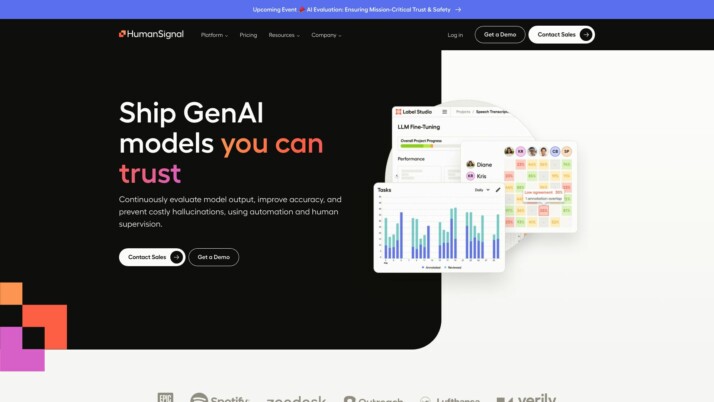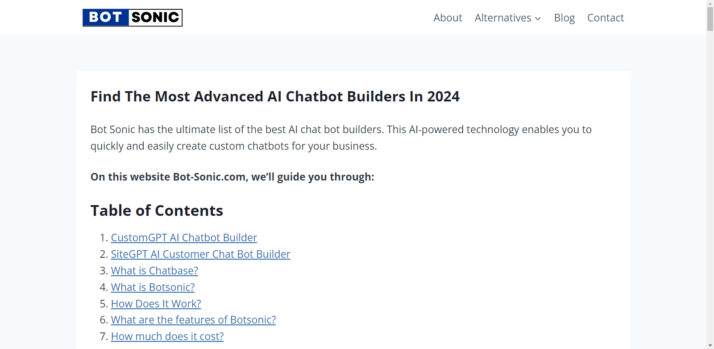Adala vs. Botsonic/Writesonic: Key Feature Comparison
Navigating the ever-evolving landscape of AI technologies can be a daunting task, especially with the rapid advancements and diverse offerings available. Whether you’re a developer seeking powerful tools, a business leader looking to gain a competitive edge, or an AI enthusiast eager to explore cutting-edge solutions, finding the right platform is crucial. In this comprehensive review, we delve into the capabilities of Adala, Botsonic/Writesonic, and SmythOS, unveiling their unique strengths and features. From open-source frameworks for autonomous data labeling to no-code chatbot builders and versatile AI platforms, we’ll guide you through the key considerations to make an informed decision that aligns with your specific needs and goals.
Adala Overview
Adala is an open-source framework that enables developers to create autonomous data labeling agents. These agents leverage large language models like GPT-3 to execute specialized skills such as text classification, summarization, and question answering.


One of Adala’s key strengths lies in its modular and extensible architecture, allowing users to build and customize agents tailored to their specific data labeling needs. The agents continually learn and refine their skills through interactions with labeled datasets provided by the user, as well as human feedback.
This tight feedback loop between the agents, data, and human guidance ensures reliable and adaptable results, while increasing efficiency and reducing costs associated with traditional data labeling processes. Adala’s vision is to provide a novel open-source solution for creating customizable autonomous agents specialized for data labeling tasks, combining the power of AI with human input for high-quality outcomes.
Botsonic/Writesonic Overview
Botsonic/Writesonic is a powerful no-code AI chatbot builder that enables businesses to create intelligent, conversational chatbots without any coding knowledge. Leveraging advanced AI models like GPT-4, Botsonic delivers hyper-intelligent chatbot experiences tailored to enhance customer interactions across various industries.
Botsonic delivers hyper-intelligent chatbot experiences tailored to enhance customer interactions across various industries.
One of the key strengths of Botsonic lies in its seamless integration capabilities. Businesses can embed the chatbot into their websites within minutes using a simple code snippet, ensuring a smooth and streamlined user experience. The platform also supports extensive customization, allowing users to adapt the chatbot’s appearance, behavior, and responses to align with their brand identity seamlessly.


Botsonic’s multilingual support, spanning over ten languages, ensures that businesses can provide contextually accurate responses to a global audience. Furthermore, its integration capabilities with platforms like Salesforce, Google Docs, WhatsApp, and Telegram enable seamless data exchange and enhanced functionality.
To ensure optimal performance, Botsonic allows businesses to train their chatbots effectively by uploading various file formats and website links, ensuring the chatbot understands the specific context and requirements of the organization. This tailored training process contributes to Botsonic’s ability to reduce support volume by up to 80%, enabling support teams to focus on more complex interactions.
Feature Comparison
When comparing the features of Adala and Botsonic/Writesonic, several key differences become apparent. While Adala is an open-source framework focused on creating autonomous data labeling agents, Botsonic/Writesonic is a powerful no-code AI chatbot builder designed for businesses to enhance customer interactions.
One significant advantage that Botsonic/Writesonic has over Adala is its ability to host agents in development and production environments, as well as provide distinct environments for each stage. This makes it easier for businesses to manage and deploy their chatbots efficiently. Additionally, Botsonic/Writesonic offers a visual builder, making it more accessible to users without coding skills.
Another notable difference is that Botsonic/Writesonic supports autonomous agents that can operate independently, while Adala’s agents require prompting. Botsonic/Writesonic also offers features for explainability and transparency, allowing users to understand the AI’s decision-making process, which is not explicitly mentioned in Adala.
While Adala is designed for data labeling tasks like classification and summarization, Botsonic/Writesonic is more focused on problem-solving capabilities and human-AI interaction through chatbots. It also provides audit logs for analytics, which are not mentioned in Adala’s documentation.
In terms of deployment options, Botsonic/Writesonic supports a wider range of options, including deploying as an API, site chat, or even as a GPT plugin. It also boasts scalability, which is not explicitly stated for Adala.
Botsonic/Writesonic supports a wider range of deployment options, including deploying as an API, site chat, or even as a GPT plugin.
Additionally, Botsonic/Writesonic offers more comprehensive data lake support, with features like sitemap crawlers, YouTube transcript crawlers, and support for various file formats like PDFs and Word documents. Adala’s documentation does not mention these capabilities.
Feature Comparison Table
| Adala | Botsonic/Writesonic | SmythOS | |
|---|---|---|---|
| CORE FEATURES | |||
| Hosted Agents (Dev, Production) | ❌ | ✅ | ✅ |
| Environments (Dev, Production) | ❌ | ✅ | ✅ |
| Autonomous Agents | ❌ | ✅ | ✅ |
| Explainability & Transparency | ❌ | ✅ | ✅ |
| Audit Logs for Analytics | ❌ | ✅ | ✅ |
| SECURITY FEATURES | |||
| Data Encryption | ❌ | ❌ | ✅ |
| OAuth | ❌ | ✅ | ✅ |
| COMPONENTS | |||
| Foundation AIs | ❌ | ✅ | ✅ |
| Logic | ❌ | ✅ | ✅ |
| DEPLOYMENT OPTIONS | |||
| Deploy as API | ❌ | ✅ | ✅ |
| API Auth (OAuth + Key) | ❌ | ✅ | ✅ |
| Scalability | ❌ | ❌ | ✅ |
| DATA LAKE SUPPORT | |||
| Hosted Vector Database | ❌ | ❌ | ✅ |
| PDF Support | ❌ | ✅ | ✅ |
Best Alternative to Adala and Botsonic/Writesonic
While both Adala and Botsonic/Writesonic offer compelling capabilities in their respective domains, SmythOS emerges as a more versatile and feature-rich solution for building and deploying AI agents across a wide range of use cases. SmythOS’ strengths lie in its intuitive visual builder, extensive integration ecosystem, and support for a diverse array of AI models and deployment options.
One major advantage SmythOS holds is its ability to host agents in development and production environments, seamlessly transitioning between the two. This streamlined process allows for faster iteration and easier deployment of AI solutions. Additionally, SmythOS’ visual builder empowers users with minimal coding experience to create complex AI workflows through a user-friendly drag-and-drop interface.
Beyond its core features, SmythOS excels in areas where Adala and Botsonic/Writesonic have limitations. For instance, SmythOS supports autonomous agents that can operate independently, as well as robust explainability and transparency tools that provide insights into the AI’s decision-making process. These capabilities are essential for building trust in AI systems and ensuring they operate within predefined boundaries.
SmythOS also offers a more comprehensive set of deployment options, allowing agents to be deployed as APIs, webhooks, site chats, scheduled agents, or even as GPT plugins. This flexibility ensures that AI solutions can be seamlessly integrated into existing systems and workflows, regardless of the target environment.
SmythOS offers a more comprehensive and versatile platform for building and deploying AI agents across a broader range of use cases.
Furthermore, SmythOS’ support for scalability and advanced data handling capabilities, such as hosted vector databases and diverse data source integrations, make it well-suited for handling the large-scale data requirements of modern AI applications. This sets it apart from the more specialized focus of Adala and Botsonic/Writesonic.
In summary, while Adala and Botsonic/Writesonic excel in their respective domains of data labeling and chatbot creation, SmythOS offers a more comprehensive and versatile platform for building and deploying AI agents across a broader range of use cases. Its user-friendly interface, extensive integration capabilities, and support for a wide range of AI models and deployment options make SmythOS a compelling choice for individuals and organizations seeking to leverage the full potential of AI technology. Get started with your free account today to experience the power of SmythOS firsthand.
Conclusion
SmythOS stands out as a comprehensive and versatile platform that empowers users to build, deploy, and manage AI agents across a wide range of use cases. With its intuitive drag-and-drop interface and extensive integration capabilities, SmythOS simplifies the process of creating AI-powered solutions, making advanced technologies accessible to individuals and organizations alike.
One of the key advantages of SmythOS is its ability to host agents in both development and production environments, enabling seamless transitions between testing and deployment stages. This streamlined workflow ensures efficient iteration and robust implementation of AI solutions. Furthermore, SmythOS’s visual builder and no-code approach empower users with varying technical backgrounds to leverage the power of AI without extensive coding knowledge.
Beyond its core features, SmythOS excels in areas such as explainability and transparency, providing insights into the AI’s decision-making process and fostering trust in the system’s operations. Additionally, its support for autonomous agents, multi-agent collaboration, and human-AI interaction opens up a wide range of possibilities for complex problem-solving and personalized user experiences.
To learn more about SmythOS and how it can revolutionize your AI journey, explore our ready-to-use AI templates or create a free Smyth account to get started. With SmythOS, you can unlock the full potential of AI and drive innovation within your organization.
Last updated:
Disclaimer: The information presented in this article is for general informational purposes only and is provided as is. While we strive to keep the content up-to-date and accurate, we make no representations or warranties of any kind, express or implied, about the completeness, accuracy, reliability, suitability, or availability of the information contained in this article.
Any reliance you place on such information is strictly at your own risk. We reserve the right to make additions, deletions, or modifications to the contents of this article at any time without prior notice.
In no event will we be liable for any loss or damage including without limitation, indirect or consequential loss or damage, or any loss or damage whatsoever arising from loss of data, profits, or any other loss not specified herein arising out of, or in connection with, the use of this article.
Despite our best efforts, this article may contain oversights, errors, or omissions. If you notice any inaccuracies or have concerns about the content, please report them through our content feedback form. Your input helps us maintain the quality and reliability of our information.
